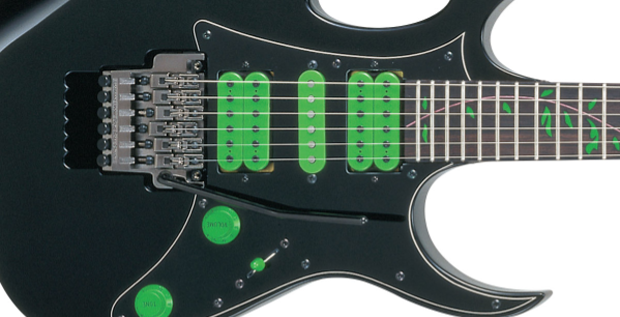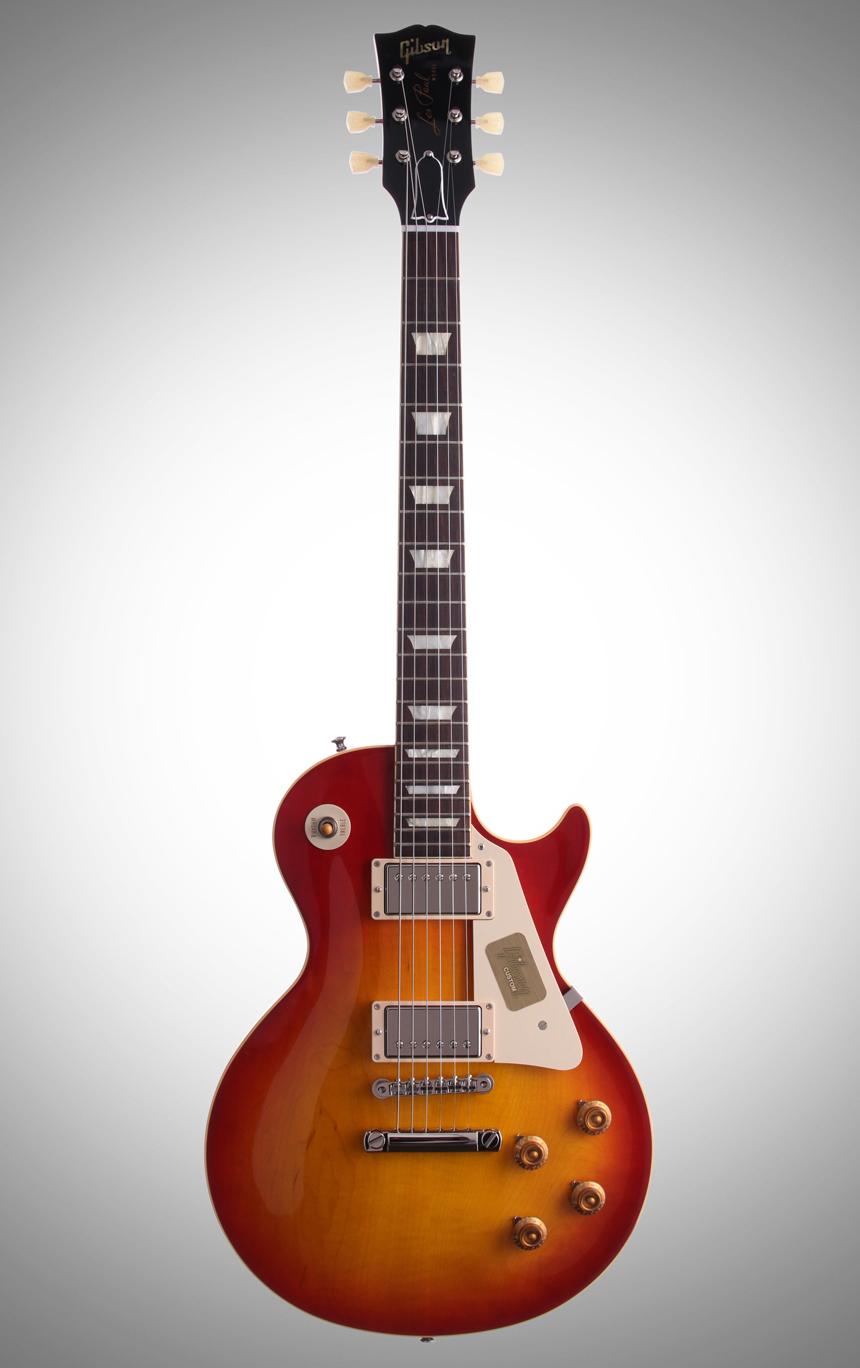The Name Game: A History of Signature Guitars

For nearly two centuries, signature guitars have allowed players to sound more like their idols—and helped manufacturers sell more gear. Guitar World presents a history of the ever-popular phenomenon.
Ever since guitarists started gaining fame and fortune from their artistry, there have been players who wanted to emulate them. In response, guitar makers have created signature model guitars bearing the names of celebrated musicians.
As far back as the 1830s, top luthiers like Johann Stauffer and René Lacote were collaborating with leading guitarists of the day, including Luigi Lagnani, Fernando Sor and Napoléon Coste, to create custom models. This includes what are possibly the first seven-string guitars, designed by Coste and Lacote, some of which bear Coste’s name handwritten on the label inside the body.
The premise back then was much the same as it is today: as well-known and accomplished guitarists achieved new vistas of tone and technique, they lent their names and/or expertise to the design of instruments that—presumably—could help ordinary players attain similar musical feats. Even if you lacked the creative soul and dexterous fingers of a Sor, Hendrix or Vai, at least you could have the same kind of guitar.
The vogue for signature guitars escalated in the late Twenties and early Thirties as our modern concept of celebrity took shape around new innovations in entertainment technology such as phonograph records and movies with synchronized sound. The prime example of this phenomenon is the Gibson Nick Lucas model flattop acoustic, which was introduced in the late Twenties.
Lucas was a key figure in the guitar’s ascendancy over the banjo, which had been popular with dance bands of the era, and he recorded what is hailed as the first guitar instrumental record, “Pickin’ the Guitar,” backed with “Teasin’ the Frets,” in 1922. Lucas was seen by crowds of moviegoers playing his Gibson signature model while singing “Tip-Toe Thru the Tulips with Me” in the hit 1929 film Gold Diggers of Broadway, which today serves as an early example of guitar-industry-related product placement.
Another trend in the Thirties and Forties was to honor guitar teachers and big-band jazz players with signature models. Guitar culture is littered with names like Roy Smeck, Harry Volpe and George Van Eps, who are remembered today more for lending their names to signature guitars—for Kay, Epiphone and Gretsch, respectively—than for their music.
Signature models became even more prominent as the electric guitar began to go viral in the mid Fifties. The best known of these, of course, is the Gibson Les Paul, which was introduced in 1952. Les Paul had become known in the mid Fifties as an accomplished guitarist, technological innovator and early television personality through his work with singer/guitarist Mary Ford, not to mention Paul Whiteman, Bing Crosby and the Andrews Sisters. He was an ideal choice to lend his name to Gibson’s first foray into the solidbody electric market following the runaway success of Fender’s Broadcaster/Telecaster at the dawn of the Fifties.
Of course, the guitar that bears Les Paul’s name was mostly designed by Gibson president Ted McCarty. Paul’s only contributions were the initial models’ goldtop finish and the original trapeze tailpiece, which most guitarists hated because it wasn’t conducive to palm muting and was hence quickly replaced by the Tune-o-matic stop tailpiece.
These days, guitarists who lend their name to a signature model often have some input on the instrument’s design, but the Gibson Les Paul is a case in which the artist allowed his name to be used to increase the product’s prestige and, hence, its sales.
Then there are legendary quasi-signature models, like the Fender “Mary Kaye” Stratocaster. The Mary Kaye Trio were a Las Vegas act who hit the Billboard charts in 1959 with their song “You Can’t Be True Dear.” When Mary Kaye and her group were depicted in an ad for Fender’s mid-Fifties Stratocaster with White Blonde finish and gold-plated hardware, this gorgeous and highly collectible iteration of the classic Strat design became forever associated with her name.
The other great signature models of the Fifties were the Gretsch archtop electrics that bore Chet Atkins’ name on the pickguard: the 6120, Country Gentleman and Tennessean. Known as Mr. Guitar, Atkins was a widely respected country player and the producer of many of Elvis Presley’s greatest hits for RCA records. Several of the Atkins models were adopted by later players including Duane Eddy, Eddie Cochran and George Harrison.
Which brings up an interesting point. While the Sixties were an era of guitar innovation—thanks to musicians like George Harrison, Roger McGuinn, Eric Clapton, Jimmy Page, Jeff Beck and Jimi Hendrix—none of them had signature models in the Sixties. The big signature guitars of the era were jazzy high-end archtops like Gibson’s Barney Kessel, Tal Farlow and Trini Lopez models. While companies like Rickenbacker, Vox and Hofner certainly advertised their association with the Beatles, there was still an industry-wide feeling that rock music was a passing fad and not to be enshrined with something as serious and lasting as a signature model.
If you were an incipient rock and roll guitar player in, say, 1965 and you wanted to sound like George Harrison, you’d do your best to find a Rickenbacker 360 12-string or a Gretsch Country Gentleman—by no means an easy feat at the time. The thought of buying a guitar with Harrison’s name on it, or one designed by him, wouldn’t have entered your head. One simple reason for this is that the influential rock guitarists of the day were, for the most part, playing recent stock models. There was no sense of “vintage” at the time, and no aftermarket replacement pickups, hardware and so on with which to customize a guitar.
All that changed in the late Seventies and early Eighties, when guitarists began to value older instruments more highly than newer guitars. This was also when the advent of replacement pickups, hardware, bodies and necks from companies like DiMarzio, Seymour Duncan, Allparts and others brought about a vogue for “hot-rodding” guitars.
A key instrument in this phenomenon was Eddie Van Halen’s Frankenstein, a bricolage assembly of parts from different manufacturers (including a Stratocaster-style body) born of Van Halen’s desire to combine the best tonal qualities of Gibson and Fender’s archetypal rock and roll electrics. By this point in time, it was clear that rock music was here to stay, and Van Halen’s hybrid approach to guitar building was brought to market in a series of popular signature models such as the Kramer 5150 and Charvel EVH.
Virtuoso metal guitar playing did much to fuel the market for innovative signature models in the Eighties. Perhaps the most wildly popular examples of this trend are Ibanez’s Joe Satriani signature models (the JS Series) and Steve Vai’s signature Ibanez JEM models with their flashy “monkey grip” body cutout.
Just as George Harrison ignited Beatlemania on a Gretsch Chet Atkins guitar and Johnny Ramone made punk rock history on a Mosrite Ventures model, Vai’s seven-string JEMs were eagerly adopted by a new generation of rap metal and extreme metal players. Players ranging from Korn’s Brian “Head” Welch and James “Munky” Schaffer to Tosin Abasi were inspired by Vai to play Ibanez seven-strings and would go on to have their own signature models.
But the signature model market hasn’t all been about metal. When Fender got into the game in 1988 with its own line of signature Stratocasters, the company honored Eric Clapton as well as Yngwie Malmsteen with their own models. Both guitars incorporated custom features originated by the artists themselves, such as Malmsteen’s scalloped fretboard and the Fender Lace pickups and midrange boost circuitry that Clapton favored at that time. Signature Strats bearing legendary names like Jeff Beck, Buddy Guy, Stevie Ray Vaughan and Jimi Hendrix all hit the market in the ensuing years.
Today, signature models are a vital part of pretty much every guitar manufacturer’s product range. And you don’t necessarily have to be a virtuoso to get your name on a guitar these days. Along with supermodel girlfriends and free designer clothes, a signature model guitar is one of the standard perks of modern pop stardom.



Get The Pick Newsletter
All the latest guitar news, interviews, lessons, reviews, deals and more, direct to your inbox!
In a career that spans five decades, Alan di Perna has written for pretty much every magazine in the world with the word “guitar” in its title, as well as other prestigious outlets such as Rolling Stone, Billboard, Creem, Player, Classic Rock, Musician, Future Music, Keyboard, grammy.com and reverb.com. He is author of Guitar Masters: Intimate Portraits, Green Day: The Ultimate Unauthorized History and co-author of Play It Loud: An Epic History of the Sound Style and Revolution of the Electric Guitar. The latter became the inspiration for the Metropolitan Museum of Art/Rock and Roll Hall of Fame exhibition “Play It Loud: Instruments of Rock and Roll.” As a professional guitarist/keyboardist/multi-instrumentalist, Alan has worked with recording artists Brianna Lea Pruett, Fawn Wood, Brenda McMorrow, Sat Kartar and Shox Lumania.
“I met Joe when he was 12. He picked up a vintage guitar in one store and they told him to leave. But someone said, ‘This guy called Norm will let you play his stuff’”: The unlikely rise of Norman’s Rare Guitars and the birth of the vintage guitar market
“This would make for the perfect first guitar for any style of player whether they’re trying to imitate John Mayer or John Petrucci”: Mooer MSC10 Pro review

